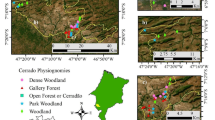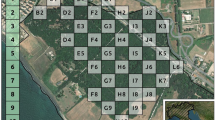Abstract
Epiphytic lichen vegetation onFagus sylvatica sas studied in 4 sites along an altitudinal gradient from 930 to 1500 m on SE facing slopes of Mount Olympos (Greece). The crucial factor determining the spatial heterogeneity of epiphytic lichens onF. sylvatica is the altitude and not the height on the trunk at which lichen community is established. 17 out of 26 taxa are confined to a particular elevation range, while another three are clearly ubiquitous in their distribution. The number of lichen species at breast height is higher than at the base of the trunks. The results were compared with those gathered earlier in an analogous study on the vertical distribution of epiphytic lichens onPinus nigra along an altitudinal gradient from 750 to 1510 m of the same mountain. Comparison suggests that spatial heterogeneity of epiphytic lichens onF. sylvatica is different from the one onP. nigra.
Similar content being viewed by others
References
Brodo, I. M. 1968. The lichens of Long Island, New York: A vegetational and floristic analysis. Bulletin New York State Museum and Science Service 410: 1–330.
Brodo, I. M. 1973. Substrate Ecology. In: Ahmadjian, V. & Hale, M. E. (eds.), The Lichens. Academic Press, New York-London.
Culberson, W. L. 1955a. The corticolous communities of lichens and bryophytes in the upland forests of northern Winsconsin. Ecological Monographs 25: 215–231.
Culberson, W. L. 1955b. Qualitative and quantitative studies on the distribution of corticolous bryophytes and lichens in Wisconsin. Lloydia 18: 25–36.
Degelius, G. 1964. Biological studies of the epiphytic vegetation of Twigs ofFraxinus excelsior. Acta Horti Gotoburgensis. 27: 11–55.
Eversman, S. 1982. Epiphytic lichens of a Ponderosa pine forest in Southeastern Montana. Bryologist 85: 204–213.
Eversman, S., Johnson, C. & Gustafson, D. 1987. Vertical distribution of epiphytic lichens in three tree species in Yellowstone National Park. Bryologist 90: 212–216.
Green, R. H. 1979. Sampling design and statistical methods for environmental biologists. John Wiley & Sons, New York, Chichester, Brisbane, Toronto.
Hale, M. E.Jr. 1952. Vertical distribution of cryptogams in a virgin forest in Wisconsin. Ecology 33: 398–406.
Hale, M. E.Jr. 1955. Phytosociology of corticolous cryptogams in the upland forests of southern Wisconsin. Ecology 36: 45–63.
Harris, G. P. 1971. The ecology of corticolous lichens. I. The zonation on oak and birch in South Devon. Journal of Ecology 59: 431–439.
Hill, M. O. & Gauch, H. G. 1980. Detrended correspondence analysis, an improved ordination technique. Vegetatio 42: 47–58.
Hill, M. O., Bunce, R. G. H. & Shaw, M. W. 1975. Indicator species analysis, a divisive polythetic method of classification, and its application to a survey of native pinewoods in Scotland. Journal of Ecology 63: 597–613.
I. G. M. E. 1978–1983. Geological map of Greece. Institute of Geology and Mineral Exploration.
James, P. W., Hawksworth, D. L. & Rose, F. 1977. Lichen communities in the British Isles: a preliminary conspectus. In: Seaward, M. R. D. (ed.), Lichen ecology. Academic Press, London, New York & San Francisco.
Kalgutkar, R. M. & Bird, C. D. 1969. Lichens found onLarix Iyalii andPinus albicaulis in southwestern Alberta, Canada. Canadian Journal of Botany 47: 627–648.
Nimis, P. L. 1984. Phytosociology, ecology and phytogeography of epiphytic lichen vegetation in the Calamone Lake Area (N-Apennines, Italy). Studia Geobotanica 4: 109–127.
Pike, L. H., Denison, W. C., Tracy, D. M., Sherwood, M. A. & Rhoades, F. M. 1975. Floristic survey of epiphytic lichens and bryophytes growing on old-growth conifers in Western Oregon. Bryologist 78: 389–402.
Pirintsos, S. A., Vokou, D., Diamantopoulos, J. & Galloway, D. J. 1993a. An assessment of the sampling procedure for estimating air pollution using epiphytic lichens as indicators. Lichenologist 25: 165–173.
Pirintsos, S. A., Diamantopoulos, J. & Stamou, G. P. 1993b. Analysis of the vertical distribution of epiphytic lichens onPinus nigra (Mount Olympos-Greece) along an altitudinal gradient. Vegetatio 109: 63–70.
Polunin, O. 1980. Flowers of Greece and the Balkans. Oxford University Press, Oxford.
Purvis, O. L., Coppins, B. J., Hawksworth, D. L., James, P. W. & Moore, D. M. 1992. The Lichen Flora of Great Britain and Ireland. Natural History Museum Publications in association with the British Lichen Society.
Rose, F. 1976. Lichenological indicators of age and environmental continuity in woodlands. In: Brown, D. H., Hawksworth, D. L. & Bailey, R. H. (eds.), Lichenology: Progress and Problems. Academic Press, London, New York & San Francisco.
Strid, A. 1980. Wild flowers of Mount Olympus. Goulandris Natural History Museum, Athens.
Author information
Authors and Affiliations
Rights and permissions
About this article
Cite this article
Pirintsos, S.A., Diamantopoulos, J. & Stamou, G.P. Analysis of the distribution of epiphytic lichens within homogeneousFagus sylvatica stands along an altitudinal gradient (Mount Olympos, Greece). Vegetatio 116, 33–40 (1995). https://doi.org/10.1007/BF00045275
Accepted:
Issue Date:
DOI: https://doi.org/10.1007/BF00045275




